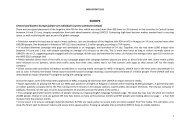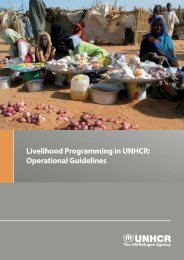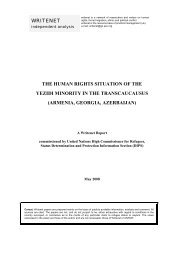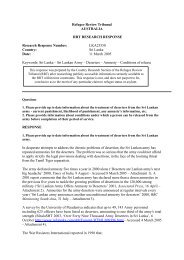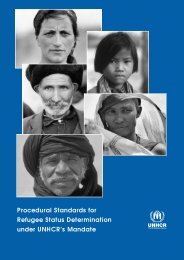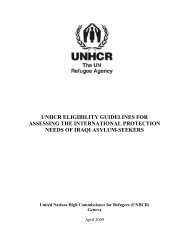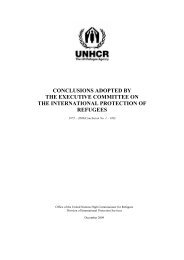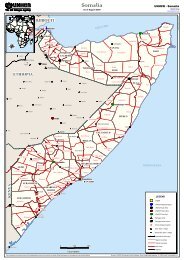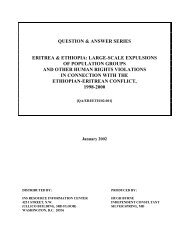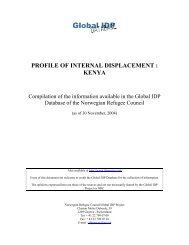UNHCR's ELIGIBILITY GUIDELINES FOR ASSESSING THE ...
UNHCR's ELIGIBILITY GUIDELINES FOR ASSESSING THE ...
UNHCR's ELIGIBILITY GUIDELINES FOR ASSESSING THE ...
You also want an ePaper? Increase the reach of your titles
YUMPU automatically turns print PDFs into web optimized ePapers that Google loves.
II. BACKGROUND IN<strong>FOR</strong>MATION<br />
A. Security, Political and Human Rights Situation<br />
Since the invasion of Iraq in March 2003 by the US-led Coalition Forces and the fall of the<br />
Saddam Hussein regime shortly thereafter, Iraq has been plagued by extreme violence<br />
perpetrated for sectarian or political reasons, as well as a general collapse of the law and<br />
order system. A number of positive political developments have taken place, including the<br />
approval of a Constitution 9 in October 2005, the holding of Council of Representatives<br />
elections in December 2005, and the formation of a national unity government in May<br />
2006. On the other hand, there have been limited tangible improvements in the political or<br />
security situation. Despite the priority apparently given by the Iraqi authorities to reestablishing<br />
security and furthering national reconciliation, the situation has deteriorated<br />
over the past year, particularly in areas where mixed religious or ethnic groups reside. Daily<br />
suicide attacks, bombings, kidnappings and assassinations have become widespread and<br />
common in most of Central and Southern Iraq. Sectarian violence has fully erupted since<br />
the bombing of a holy Shi’ite shrine in Samarra in February 2006. The civilian death toll is<br />
high and millions of Iraqis have been displaced within and outside of Iraq. 10<br />
Daily life in Iraq, largely with the exception of the three Northern Governorates of<br />
Sulaymaniyah, Erbil and Dahuk, has been ruled by an extremely precarious security and<br />
human rights situation. Iraq’s ethnic and religious mosaic is threatened by sectarian<br />
violence, in particular the escalation of violence between its Shi’ite and Sunni populations.<br />
Tensions and violence are also rising among the Arab, Turkmen and Kurdish communities<br />
as well as with other minorities. Even within the Shi’ite majority, tensions often flare<br />
among its political representatives and its armed militias. 11 Other religious and ethnic<br />
groups thus find themselves in an increasingly hostile environment.<br />
9 See “Constitutional and Legislative Situation”.<br />
10 According to UNAMI HRO, a total of 34,452 civilians have been violently killed and 36,685 wounded in<br />
2006 only; see: UNAMI HRO, Human Rights Report, 1 November – 31 December 2006, p. 2 and 4,<br />
http://www.uniraq.org/FileLib/misc/HR Report Nov Dec 2006 EN.pdf (further: “UNAMI HRO, December<br />
2006 Human Rights Report”). The Iraqi Government’s estimate is considerably lower, at 12,357 persons<br />
killed in 2006; see: Ewen MacAskill, UN clashes with Iraq on civilian death toll, The Guardian, 17 January<br />
2007, http://www.guardian.co.uk/Iraq/Story/0,,1992010,00.html. See also the website of “Iraq Body Count”,<br />
which is run by academics and peace activists and bases its figures on reports from at least two public media<br />
sources. It estimates that between 56,256 and 61,974 civilians have been killed since the beginning of the<br />
conflict (by 14 February 2007); see: Iraq Body Count, The Iraq Body Count Database, available at<br />
http://www.iraqbodycount.net/database. Finally, a US research team, led by Gilbert Burnham of Johns<br />
Hopkins Bloomberg School of Public Health, estimates that 655,000 Iraqis, or around one in 40 of the Iraqi<br />
population, have died as a result of the 2003 invasion of their country; see: Gilbert Burnham, Riyadh Lafta,<br />
Shannon Doocy, Les Roberts, Mortality after the 2003 invasion of Iraq: a cross-sectional cluster sample<br />
survey, The Lancet, 11 October 2006, http://www.thelancet.com/webfiles/images/journals/lancet/<br />
s0140673606694919.pdf.<br />
11 Members of the Shi’ite coalition at times threaten to leave the alliance or suspend their participation in<br />
the Council of Representatives or the Cabinet. For example, the political movement of Shi’ite cleric Muqtada<br />
Al-Sadr boycotted the Council of Representatives for a period of two months in late 2006/early 2007; see:<br />
BBC News, Sadr group ends political boycott, 21 January 2007, http://news.bbc.co.uk/2/hi/<br />
middle_east/6283975.stm. In addition, Shi’ite militias, in particular the Badr Organization and Mehdi Army,<br />
23




